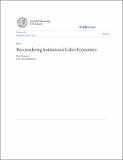Institutional labor economics, the new personnel economics, and internal labor markets: A reconsideration
Author(s)
Osterman, Paul
DownloadOsterman_DEP Jan 13-Reconsidering institutional.pdf (212.7Kb)
PUBLISHER_POLICY
Publisher Policy
Article is made available in accordance with the publisher's policy and may be subject to US copyright law. Please refer to the publisher's site for terms of use.
Terms of use
Metadata
Show full item recordAbstract
The author illustrates the utility of institutional labor economics and makes a case for a reconsideration of it. Two recent developments motivate this effort: the rise of New Personnel Economics (NPE) as a significant subfield of labor economics and the substantial shifts in work organization that have taken place since the 1990s. Understanding how and why firms have reorganized work opens the door for a renewed interest in institutional approaches. The author explains that the rules of institutional labor markets (ILMs) emerge from the competition between organizational interest groups—unions, personnel professionals, and the government—and competing views of firms’ objectives—resulting in the rise of ILMs, the slow diffusion of High Performance Work Systems, strategies used to obtain a high level of commitment from workers, the use of contingent employees, and the spread of new promotion rules in response to equal employment opportunity pressures. As such, the role of power and influence in establishing work rules is of central concern, though more conventional NPE considerations also remain important.
Date issued
2011-07Department
Sloan School of ManagementJournal
ILRReview
Publisher
New York State School of Industrial and Labor Relations, Cornell University
Citation
Osterman, Paul. "Reconsidering Institutional Labor Economics." ILRReview 64.4 (2011): 637-652.
Version: Final published version
ISSN
0019-7939